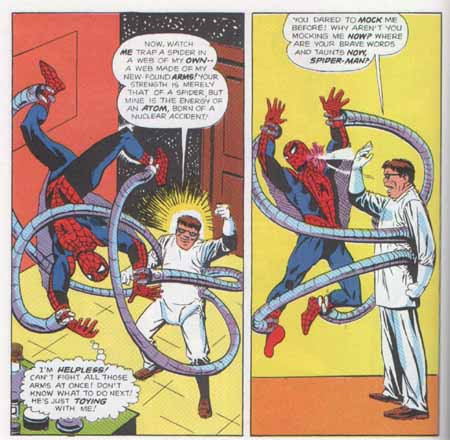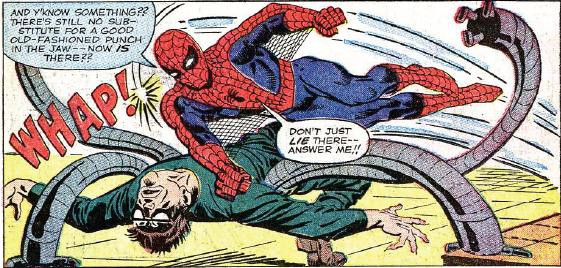When you watch Spider-Man clash with Doctor Octopus, especially in iterations like Spider-Man 2, a nagging question might pop into your head: How is Doc Ock still standing after taking a punch from Spider-Man? After all, Spider-Man possesses superhuman strength, capable of lifting tons. Shouldn’t a direct hit from the wall-crawler turn the good doctor’s face into mush? This is a question that has puzzled fans across different media, from comics to the big screen.
To effectively translate these battles to movies without resorting to excessive CGI or unbelievable scenarios, filmmakers often need to subtly address this discrepancy. The common workaround? Suggesting some form of enhanced durability for Doctor Octopus. This could manifest as implied body armor, skeletal reinforcement, or some other sci-fi explanation – often quickly glossed over – to justify why a punch from Spider-Man doesn’t result in a lengthy hospital stay for Otto Octavius. However, the truth is, this crucial detail is rarely explicitly addressed, leaving fans to wonder about the physics of these superhero showdowns.
Spider-Man vs. Doctor Octopus: Strength and Vulnerability
Let’s break down the power dynamics. Spider-Man’s strength is famously variable, depending on the comic writer and the story’s needs. Generally, it’s portrayed as ranging from an astonishing 8 to 20 tons. However, a key aspect of Spider-Man’s character is his restraint. He constantly holds back his full power when fighting ordinary humans to avoid accidental fatalities. He only unleashes his true strength against opponents proven capable of withstanding it, like the cosmic entity Firelord.
 Doctor Octopus's initial comic appearances showcased arms so swift and forceful that Spider-Man struggled to compete.
Doctor Octopus's initial comic appearances showcased arms so swift and forceful that Spider-Man struggled to compete.
Doctor Octopus’s initial comic appearances showcased arms so swift and forceful that Spider-Man struggled to compete.
On the other side, Doctor Octopus’s mechanical arms are formidable. Their strength depends on their construction material, evolving from titanium to adamantium and later carbonadium in the comics. These advanced iterations allow Doc Ock to rival Iron Man and even hold his ground against the Hulk, easily surpassing Spider-Man’s strength in terms of raw power output from the arms. However, this superhuman durability is exclusive to his tentacles. Otto Octavius himself remains biologically human, and critically, his face is just as vulnerable as any ordinary person’s.
This is where the central issue arises. Without any explicit enhancement to his physical form, a solid punch from Spider-Man should realistically inflict devastating damage to Doctor Octopus’s unarmored head. This point of contention becomes a “medium translation error” – something often overlooked or hand-waved in adaptations for the sake of streamlined storytelling and visual spectacle.
Comic Book Battles: A Dance of Dodges and Defensive Arms
In the comic books, Spider-Man and Doctor Octopus are frequent adversaries, their battles a cornerstone of Spider-Man lore. Interestingly, Spider-Man is often depicted as the underdog in these encounters. Doctor Octopus’s mechanical arms are incredibly fast, demanding Spider-Man’s spider-sense to work overtime just to evade being impaled or crushed.
Because of the exceptional speed and reach of his arms, Doctor Octopus rarely absorbs direct body blows from Spider-Man. His tentacles act as a near-impenetrable defense. They are more than quick enough to match Spider-Man’s agility, instinctively blocking attacks at the last moment, shielding Otto’s vulnerable body and face like a seasoned boxer’s guard.
This dynamic creates some of Spider-Man’s most challenging and strategically complex fights. While Doctor Octopus’s human body is fragile, his arms create a protective zone that Spider-Man cannot easily penetrate. Getting too close risks being ensnared by the powerful tentacles, which are capable of tearing Spider-Man apart.
 Encounters between Doctor Octopus and Spider-Man often depicted them as evenly matched, highlighting Doc Ock's strategic brilliance despite his human fragility.
Encounters between Doctor Octopus and Spider-Man often depicted them as evenly matched, highlighting Doc Ock's strategic brilliance despite his human fragility.
Encounters between Doctor Octopus and Spider-Man often depicted them as evenly matched, highlighting Doc Ock’s strategic brilliance despite his human fragility.
Comic Book Solutions: Telekinesis and Exoskeletons
The comic book writers eventually addressed this durability paradox, albeit decades after Doctor Octopus’s debut. The explanation, seemingly conceived after years of continuity, was that Otto Octavius possessed a subtle mutation granting him low-level telekinesis. This power, it was implied, subconsciously provided a degree of protection, preventing him from being instantly incapacitated by Spider-Man’s blows. In the Ultimate Marvel universe, this issue was sidestepped entirely by giving Doctor Octopus a full-body, super-powered exoskeleton from the outset.
In the main Earth-616 continuity, recognizing the increasing toll of years of super-powered brawls on Doctor Octopus’s aging body, writers introduced an exoskeletal harness. This addition served both to explain his continued resilience and to reflect the character’s physical decline.
 Doctor Octopus's evolution from his initial appearance to his later design featuring exo-life support armor, reflecting his growing vulnerability and technological adaptation.
Doctor Octopus's evolution from his initial appearance to his later design featuring exo-life support armor, reflecting his growing vulnerability and technological adaptation.
Doctor Octopus’s evolution from his initial appearance to his later design featuring exo-life support armor, reflecting his growing vulnerability and technological adaptation.
Wikipedia notes this evolution, stating that Doctor Octopus began wearing full-body armor due to a debilitating illness exacerbated by years of accumulated injuries. Despite delivering superhuman punishment, his ability to withstand damage remained human. He became completely reliant on his arms for defense, and the new suit, binding his original arms and adding four more tentacles, along with psychokinetic control over “Octobots,” became necessary for his survival and continued villainy.
The Ironic Twist: Experiencing Spider-Man’s Power Firsthand
In a truly ironic turn of events, when Doctor Octopus famously swapped bodies with Peter Parker, taking over Spider-Man’s physique, he gained a visceral understanding of Spider-Man’s power. In a moment of uncontrolled rage within Spider-Man’s body, Octavius accidentally punched off the jaw of the Scorpion. This shocking display highlighted the immense strength Peter Parker routinely held in check, a power level Otto Octavius had previously only tangentially comprehended from the receiving end of Spider-Man’s restrained attacks.
 An ironic moment where Doctor Octopus, in Spider-Man's body, unintentionally unleashes Spider-Man's true strength, demonstrating the power he usually faces.
An ironic moment where Doctor Octopus, in Spider-Man's body, unintentionally unleashes Spider-Man's true strength, demonstrating the power he usually faces.
In conclusion, while the question of Doctor Octopus’s durability against Spider-Man’s strength might seem like a minor detail, it delves into the fascinating intricacies of superhero power scaling and adaptation across different media. Whether through implied enhancements, comic book retcons, or simply a suspension of disbelief, the battles between Spider-Man and Doctor Octopus remain iconic, even if the physics sometimes require a bit of imaginative interpretation.

